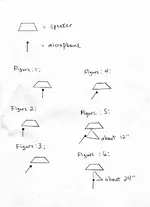I am attaching a .jpg of some commonly used guitar cabinet positions.
Figure 1:
Assuming you place the mic about 2" from the speaker, this position will generally provide a sort of "hollow" sound (lot of high and low end). I use this more for clean guitar sounds.
Figure 2:
At around 2" from the speaker, this position can be usefull if you desire more lower end in the sound. For really bright guitar tones that I need warmed up a bit, I like this position.
Figure 3:
This position will REALLY capture a lot of low end. At close distance, with the mics proximity effect, and the fact that you are blasting the diaphram with the low end of the tone produced at the edge of the speaker at the direction it radiates from the speaker, this can be a dangerous place to mic from.
Figure 4:
At around 2" from the speaker, this position usually retains the desired balance between low and high end in the tone. I use this position 80% of the time I close mic a cabinet if the volume is sort of low.
Figure 5:
This is probably the most used position I end up using for distorted guitar when the amp is loud. I show 12" as the distance, but this can be as far away as 18" if the amp is really loud. I never start at this position, but usually wind up around here.
Figure 6:
Great for clean tones! Even better if you use a large diaphram condensor mic at this position!
A thing to remember about micing guitar cabinets is that compared to listening to the amp in the room, in the control room through monitors, the sound will obviously be less in volume and tend to sound "plainer" and not as big. If the EXACT sound you hear in the room with the amp is desired, you will need to consider ambient micing techniques. You are going to need a very good sounding room, and a lot of time experimenting with mic placement to make ambient micing techniques work for you. A lot of times, close micing and recording two tracks of the same part will produce very powerful results with a very "in your face" type of sound, if the original tone of the amp is played with work with the mic placement.
I agree with the above statements about preamp gain on the amp. The more distortion you start with, the harder it will be to make the tone stick out in a mix. Too little gain though and you have a tone that doesn't "gel" with the other parts. The tone in this case will seem possibly too "obvious" in the mix. Experimintation rules here!
I have found amp simulators work best when they are used over fake drums. Over a real drum kit, they tend to sound either too up front, or too far away in the mix. Mic'ed guitar though, when recorded properly, can sound very good with either fake or real drums. It really comes down to matching the guitar tone with the rest of the instruments in terms of "depth". If most other things in the mix are ambient, your guitar should be too. If most other things are "in your face" and close mic'ed, your guitar should probably too. These are production decisions one must make, and certainly, there are not "rules" per se.
Good luck.
Ed



